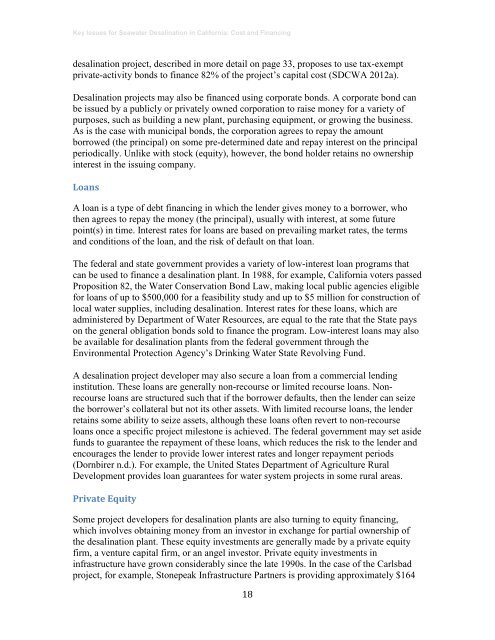997.4 KB - San Francisco Bay Area Independent Media Center
997.4 KB - San Francisco Bay Area Independent Media Center
997.4 KB - San Francisco Bay Area Independent Media Center
You also want an ePaper? Increase the reach of your titles
YUMPU automatically turns print PDFs into web optimized ePapers that Google loves.
Key Issues for Seawater Desalination in California: Cost and Financing<br />
desalination project, described in more detail on page 33, proposes to use tax-exempt<br />
private-activity bonds to finance 82% of the project’s capital cost (SDCWA 2012a).<br />
Desalination projects may also be financed using corporate bonds. A corporate bond can<br />
be issued by a publicly or privately owned corporation to raise money for a variety of<br />
purposes, such as building a new plant, purchasing equipment, or growing the business.<br />
As is the case with municipal bonds, the corporation agrees to repay the amount<br />
borrowed (the principal) on some pre-determined date and repay interest on the principal<br />
periodically. Unlike with stock (equity), however, the bond holder retains no ownership<br />
interest in the issuing company.<br />
Loans<br />
A loan is a type of debt financing in which the lender gives money to a borrower, who<br />
then agrees to repay the money (the principal), usually with interest, at some future<br />
point(s) in time. Interest rates for loans are based on prevailing market rates, the terms<br />
and conditions of the loan, and the risk of default on that loan.<br />
The federal and state government provides a variety of low-interest loan programs that<br />
can be used to finance a desalination plant. In 1988, for example, California voters passed<br />
Proposition 82, the Water Conservation Bond Law, making local public agencies eligible<br />
for loans of up to $500,000 for a feasibility study and up to $5 million for construction of<br />
local water supplies, including desalination. Interest rates for these loans, which are<br />
administered by Department of Water Resources, are equal to the rate that the State pays<br />
on the general obligation bonds sold to finance the program. Low-interest loans may also<br />
be available for desalination plants from the federal government through the<br />
Environmental Protection Agency’s Drinking Water State Revolving Fund.<br />
A desalination project developer may also secure a loan from a commercial lending<br />
institution. These loans are generally non-recourse or limited recourse loans. Nonrecourse<br />
loans are structured such that if the borrower defaults, then the lender can seize<br />
the borrower’s collateral but not its other assets. With limited recourse loans, the lender<br />
retains some ability to seize assets, although these loans often revert to non-recourse<br />
loans once a specific project milestone is achieved. The federal government may set aside<br />
funds to guarantee the repayment of these loans, which reduces the risk to the lender and<br />
encourages the lender to provide lower interest rates and longer repayment periods<br />
(Dornbirer n.d.). For example, the United States Department of Agriculture Rural<br />
Development provides loan guarantees for water system projects in some rural areas.<br />
Private Equity<br />
Some project developers for desalination plants are also turning to equity financing,<br />
which involves obtaining money from an investor in exchange for partial ownership of<br />
the desalination plant. These equity investments are generally made by a private equity<br />
firm, a venture capital firm, or an angel investor. Private equity investments in<br />
infrastructure have grown considerably since the late 1990s. In the case of the Carlsbad<br />
project, for example, Stonepeak Infrastructure Partners is providing approximately $164<br />
18
















